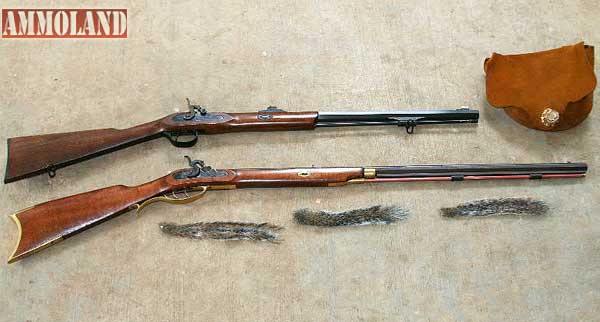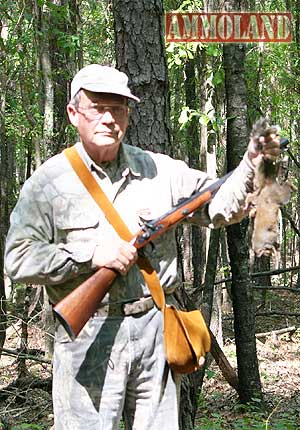By Hovey Smith


Central Georgia –-(Ammoland.com)- Guns come and go on the replica market, but two that have had some staying power are Traditions’ .32-caliber muzzleloading squirrel rifles.
These two guns are different in style and pricing, but are similarly effective.
Both guns are side-lock percussion rifles and use the relatively small No. 10 or 11 percussion caps for ignition. The Traditions Crockett .32-Caliber Percussion Rifle is the more traditional design with a half stock, set triggers, brass fittings, relatively long octagonal barrel and maple stock.
Traditions makes a variety of black powder or muzzeloading tools, that are great to have when shooting black powder rifles.
The .32-caliber version of the Traditions Deerhunter Flintlock Muzzleloader has a stock of modern design and a shorter, larger-diameter barrel. This unusually large barrel is the result of a .32-caliber hole being bored in a .50-caliber barrel blank. This expedient method of gun production allowed the same wooden stock, trigger, sights, furniture, etc., that was used on the larger-caliber deer rifle to be also employed to make a new smaller caliber squirrel gun, .
Rifle is now fitted up and stock is finished. Metal finishing comes next.
Smaller caliber rifles in .32 and .36 caliber have a lot of nostalgic appeal. They bring back the image of rugged Tennessee and West Virginia riflemen going out to gather a bag full of squirrels or pot a rabbit for his family’s supper. In many cases this might be the only rifle that the family owned.
If they had a larger .40 or .45-caliber rifle these were reserved for deer or bear hunting, as there was no need to waste that much hard to get powder and lead on small animals. Over the past three centuries wagon loads of squirrels, wild turkeys, grouse, rabbits, raccoons and even an occasional deer, bear or man was killed by .32 caliber lead spheres propelled by about 20 grains of whatever black powder could be obtained. The .32-muzzleloading rifle’s closest modern equivalent would likely be the .22 Magnum rimfire cartridge. In practice, the .32 caliber works very efficiently on small game and provides a relatively low noise load that kills well, provided that the bullets are put in the right place.
There were problems with going much smaller than the .32 caliber in muzzleloading rifles. One was that smaller-caliber guns with rifle-length barrels became more difficult to service and clean with wooden ramrods. When you are on the frontier and might have to make a replacement ramrod, it helped to have a gun where you could whittle a piece of wood to make a ramrod that was sufficiently strong to be serviceable. Another problem that I have heard of, but not verified, is that if you started to use enough powder behind .25-caliber and smaller-caliber balls to make them really effective, the balls could be melted in the bore resulting in your expelling a droplets of molten metal from the bore.

The Rifles
The Crockett rifle is offered as both a completed rifle and as a kit gun. I elected to build the kit gun as one of the guns to be featured in my forthcoming book, Building or Restoring Your Own Muzzleloader. The Crockett rifle was priced at $469 for a new gun and $419 for a kit. There is some undeniable satisfaction in taking game with a gun that you had a hand in building, but many would consider the $50 savings as to not be worth the trouble. In the process of putting the gun together I also produced five YouTube videos, which started with Assembly Traditions Crockett .32 Squirrel Rifle Kit (https://youtu.be/jFxm43Xf1s8 ) and progressed through Stock Fnish, Metal Finish, Shooting and presently ends with Tree Lounge Hunting with Traditions Crockett .32 Squirrel Rifle Kit
Although I do not usually hunt squirrels from a Tree Lounge tree stand, I did in this case to try this stand out before using it on deer and bear hunts later this year. I did not actually get to shoot a squirrel from this stand, but did take two while walking to it. The final video is this series is Squirrel Hunting with .32 Caliber Traditions’ Muzzleloading Rifles which may be seen at: https://youtu.be/jKprQ7rT2yI.
The Crockett rifle is more true in spirit than in fact so far as resembling either David Crockett’s ”Betsy” or “Old Betsy.” The last rifle survives and is a full-stocked flintlock. Once, in honor of an anniversary, 100 replicas of one of Crockett’s rifles were made and sold on a semi-custom basis. These guns still occasionally surface at used gun auctions. The rifle that Traditions made is more nearly after a small-caliber half-stocked Hawken rifle from a later era, and many makers sold half-stock small-game rifles during the 1850s-1870s, when this style reached maximum popularity.
Dimensionally, the Crockett rifle has a 32-inch barrel (24-inch for Deerhunter), length of 49-inches (40-inches for Deerhunter) and a weight of 6.75 pounds (6 pounds for the Deerhunter). The Crockett carries well in the arms while the shorter-length Deerhunter feels better slung over the back. The Crockett’s longer barrel also got in the way while trying to twist it through tight places and seemed to always clank against the deer stand each time I moved for a shot.
The solution to that is to leave the gun in the rack until you are in position and ready to aim at your animal. Then quietly get your gun and shoot.
I also found the shape of the Deerhunter’s stock more natural feeling when trying to shoot nearly straight up a tree and that its weight distribution felt better for off-hand shooting. Although I did manage to make some good off-the-shoulder shots with the Crockett, it was always better to brace the gun against a tree or another handy rest.
User modifications were made to both guns. I smoothed up the locks and trigger pulls on both of them as I usually do. The only other problem with the Deerhunter was that the front sight was much too low for close-range shooting. I happened to have a nearly appropriate sized South African coin and trimmed that down to proper height to make a replacement sight. Some fitting was expected with the Crockett Kit gun. I needed to install a piece of wood between the rear of the barrel and the stock, bend the hammer so that it would strike the nipple and make a cylinder of deer antler to fit around the sear bar so that the set triggers would strike it and drop the hammer to fire the gun. On both guns aluminum ramrods are supplied which removed the possibility of my snapping off a weak wooden rod in the barrel.
So far as accuracy was concerned, I could detect no significant differences between the two guns.
Certainly, the squirrels did not know the difference. With either gun hitting the squirrels required that the squirrels are sitting or moving very slowly. With only a single shot and a long reloading time, I did not shoot until the animal was still and I could clearly see it behind the foliage.
Whereas one might shoot at a violently shaking branch that a squirrel was working with a shotgun and expect to kill the animal, I wanted a clearly outlined target so that I could place the ball in the front quarter of the animal. I also preferred to have it the ball caught by the trunk of the tree, stream bank or hillside. These restraints limited shot opportunities.
This may be hard to believe for those who have to practically kick the fearless squirrels out of the way on college campuses and public parks.

These balls most often completely penetrated the squirrels and I have only occasionally recovered one, as I show in my video on making squirrel dumplings. That shot had raked the animal from front to back and the ball was found under the skin on the off side. While a .310 round ball weighs only 50 grains, it will usually penetrate about 2-inches of green wood. A typical load of 20 grains of FFFg sends it out of the Crockett’s barrel at about 1400 fps. giving it 218 ft./lbs. of energy. This loading is appropriate for these guns’ 1:48-inch twist barrels. The charge could be increased to 25 grains, but hotter charges will likely result in patches stripping out on these guns’ relatively fast-twist barrel and are not needed for small game.
My wild squirrels know very well that they are being hunted and are quick to head for cover or freeze in the treetops the instant I leave the house. Occasionally I will find an area where they have not been hunted for generations and in such spots it is a much simpler task to take a limit of five squirrels. At home I am fortunate to take one or two a trip. On full moon nights the squirrels will feed as much as they want at night and have no need to expose themselves during daylight.
In brief, between the two guns, I think that a person using the Deerhunter will kill more squirrels because of its better handling characteristics than with the Crockett, despite that guns higher costs ($469 vs. $299), better looks and added features. If you want to see a video of me with the Deerhunter I have Backyard Squirrel Hunting – Muzzleloader at: ( https://youtu.be/Jjwn4CDyI9M ) that provides a good look at the rifle and a bit on squirrel cleaning.
I also have videos on squirrel cooking like Squirrel Dumplings for the BBC (https://youtu.be/nOfhw1ZqTIw) where I propose cooking up a mess of squirrels for the Royal Household. The British Isles are overrun with gray squirrels, and cooking and eating them is one way to help alleviate the problem. To date, no response has been received.
The Royals often serve wild game, but I am not sure that they have had squirrels for any of their State or social functions.
About William Hovey Smith:
As a Professional Geologist and an Outdoor Writer, Hovey has had the opportunity to live and hunt over most of North America. He was always interested in outdoor writing and sold his first articles in the 1970s and have continued with newspaper, magazine and book writing every since. Hovey has done beat reporting for regional newspapers, been published in more than 80 different publications and has produced 15 books and most recently both screen and stage plays. Visit: www.hoveysmith.com
